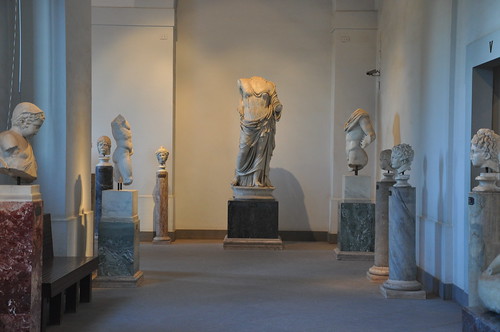
A sua entrada está incluída na visita ao Monte Palatino (que no nosso caso foi feita com o Roma Pass) e reúne vários artefactos que foram encontrados neste local, alguns serão originais mas grande parte pelo o que vimos pelas placas diziam que eram cópias. Ainda assim reúne uma impressionante colecção de bustos e esculturas, além de restos de mosaicos que decoravam as casas dos que aqui viviam.
Your admission is included in visit to Monte Palatino (which in our case was made with the Roma Pass) and it gathers several artifacts that were found at this site, some will be original but much of what we saw by it's signs said they were copies. Still it brings together an impressive collection of busts and sculptures, along with remains of mosaics that decorated the homes of those who lived here.
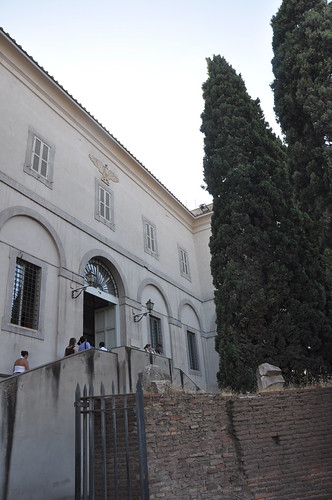
A colecção divide-se entre a história do Monte Palatino e a zona onde podemos encontrar as várias estátuas da época imperial romana.
Uma das esculturas mais relevantes é esta da Erma di Canefora realizada em bronze e que data do século I. As Canéforas ou Canephorae eram jovens virgens de familias aristocratas na Grécia Antiga que eram chamadas para liderar as procissões, geralmente carregavam cestas que continham ofertas ou objectos utilizados em sacrificios aos Deuses.
The collection is divided between the Palatine Hill and the history of the area where we can find the various statues of Roman imperial era.
One of the most important sculptures is the Erma di Canephorus made in bronze and dating from the first century The Canéforas or Canephorae were young virgins families of aristocrats in ancient Greece who were called to lead processions, usually carrying baskets containing offerings or objects used for sacrifices to the Gods.
The collection is divided between the Palatine Hill and the history of the area where we can find the various statues of Roman imperial era.
One of the most important sculptures is the Erma di Canephorus made in bronze and dating from the first century The Canéforas or Canephorae were young virgins families of aristocrats in ancient Greece who were called to lead processions, usually carrying baskets containing offerings or objects used for sacrifices to the Gods.
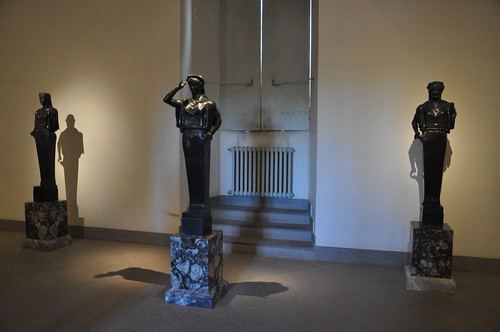
A seguinte é uma cópia de um Fanciullo Pescatore que data do século II e representaria uma criança a pescar.
The following is a copy of a Fanciullo Pescatore dating from the second century and represents a child to fish.
The following is a copy of a Fanciullo Pescatore dating from the second century and represents a child to fish.
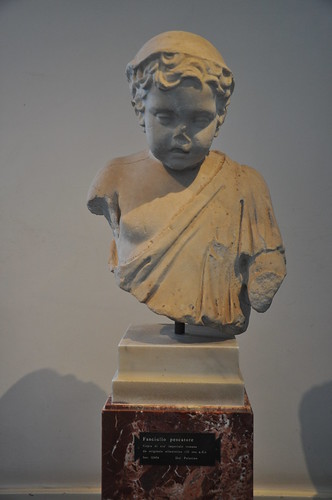
Na foto seguinte está uma escultura que segundo a inscrição representaria um príncipe da dinastia Julio-Claudiana (que se refere aos cinco primeiros imperadores romanos). Também na sua descrição está o nome Hermés, que na mitologia grega era o filho de Zeus e um dos doze deuses do Olimpo e que parece inspirar o corpo da estátua pelo corpo nu e a manta no braço esquerdo.
The picture below is a sculpture that according to the inscription would represent a prince of Julius-Claudian dynasty (which refers to the first five Roman emperors). Also in it's description there's the name of Hermes, who in Greek mythology was the son of Zeus and one of the twelve Olympian gods and that seems to inspire the body of the statue by the naked body and the blanket on the left arm.
The picture below is a sculpture that according to the inscription would represent a prince of Julius-Claudian dynasty (which refers to the first five Roman emperors). Also in it's description there's the name of Hermes, who in Greek mythology was the son of Zeus and one of the twelve Olympian gods and that seems to inspire the body of the statue by the naked body and the blanket on the left arm.
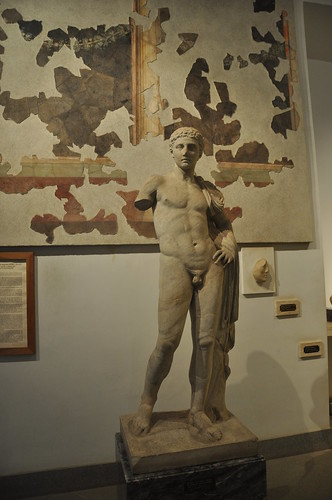
No pedaço de fresco recuperado podemos ver Apollo Citaredo, nele o deus Apolo, filho de Zeus aparece com uma lira nas mãos. Esta representação de Apolo aparece também noutras esculturas.
In the recovered piece of frescoe we can see Apollo Citaredo, in it the god Apollo son of Zeus has a lyre in his hands. This representation of him also appears in other sculptures.
In the recovered piece of frescoe we can see Apollo Citaredo, in it the god Apollo son of Zeus has a lyre in his hands. This representation of him also appears in other sculptures.
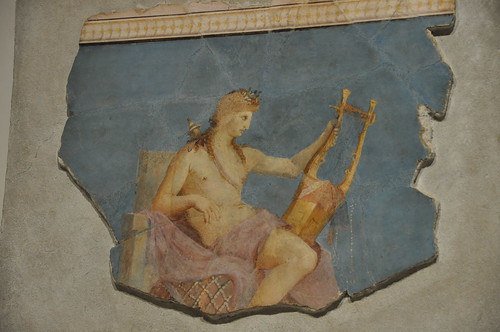
Na parede vermelha estão dois frescos que representam o Riti Bacchici, um ritual dedicado a Baco, o deus romano do vinho. Segundo a placa estariam na Domus Transitoria, o palácio do imperador Nero que foi consumido pelas chamas no grande incêndio de Roma. Ao lado estão uns mosaicos recuperados da Domus Tiberiana, o palácio do imperador Tibério.
On the red wall there are two frescoes representing Bacchici Riti, a ritual dedicated to Bacchus, the Roman god of wine. According to the sign they would be in the Domus Transitional, the palace of the emperor Nero that was consumed by flames in the Great Fire of Rome. At is side there are mosaics recovered from Domus Tiberiana, the palace of the emperor Tiberius.
On the red wall there are two frescoes representing Bacchici Riti, a ritual dedicated to Bacchus, the Roman god of wine. According to the sign they would be in the Domus Transitional, the palace of the emperor Nero that was consumed by flames in the Great Fire of Rome. At is side there are mosaics recovered from Domus Tiberiana, the palace of the emperor Tiberius.
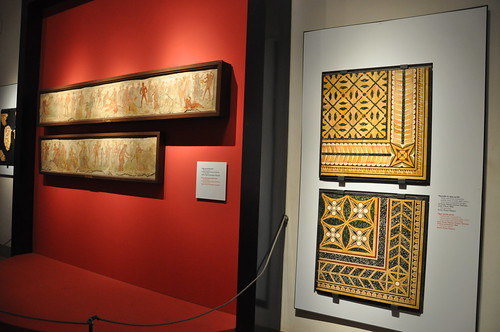
Esta interessante escultura em mármore tem a seguinte descrição Satiro che si guarda la coda. Um sátiro era uma personagem da mitologia grega metade homem, metade bode. Nesta representação ele estaria a olhar para a cauda, que com o grau de destruição da escultura não se vê.
This interesting marble sculpture has the following description Satiro guard che si la coda. A satyr was a character in Greek mythology half man, half goat. In this representation he would be looking at the tail that with the degree of destruction of the sculpture we can't see.
This interesting marble sculpture has the following description Satiro guard che si la coda. A satyr was a character in Greek mythology half man, half goat. In this representation he would be looking at the tail that with the degree of destruction of the sculpture we can't see.
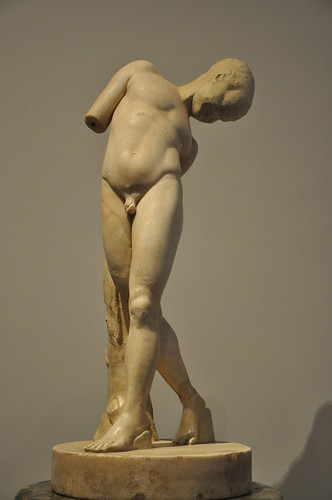
A escultura seguinte é uma cópia da criada por Kephisodotus, um escultor grego. Nele podemos ver Dionysus e segundo a descrição ele estaria ao colo do pai, Hermés.
The following is a sculpture that is a copy of the one created by Kephisodotus a Greek sculptor. In it we see Dionysus and according to the description he was in his father's lap, Hermés.
The following is a sculpture that is a copy of the one created by Kephisodotus a Greek sculptor. In it we see Dionysus and according to the description he was in his father's lap, Hermés.

No museu há alguns corpos representando mulheres, grande parte só têm o tronco, este é uma representação da deusa Ártemis, a deusa da caça, da vida animal e também virgindade e do nascimento. Era filha de Zeus e irmã gémea de Apolo. Para os romanos a mesma deusa era Diana. O que mais salta vista é o grau de detalhe da sua roupa.
In the museum there are some bodies representing women, most only have the trunk, this is a representation of the goddess Artemis, goddess of hunting, animal life and also virginity and birth. She was the daughter of Zeus and twin sister of Apollo. For the Romans it was the goddess Diana. What really catchs your eye is the degree of detail of their clothing.
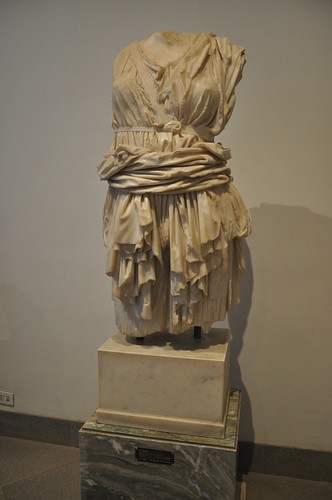
Por último, uma cópia romana de um original grego que representa uma estátua dupla de Dionysus, a que está atrás será a sua versão mais jovem e a da frente já em adulto.
Finally, a Roman copy of a Greek original statue representing a pair of Dionysus, the one standing behind is its younger version and in front the adult.
Finally, a Roman copy of a Greek original statue representing a pair of Dionysus, the one standing behind is its younger version and in front the adult.
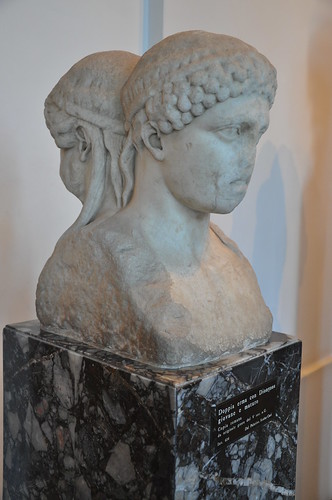
Apesar do post extenso, a exposição em si não é muito grande, aqui ficam mais imagens de outras esculturas que vimos no interior do museu.
Althoug it is a long post, the exhibition itself isn't very big, I leave here more pictures of other sculptures we saw inside this museum.
Althoug it is a long post, the exhibition itself isn't very big, I leave here more pictures of other sculptures we saw inside this museum.
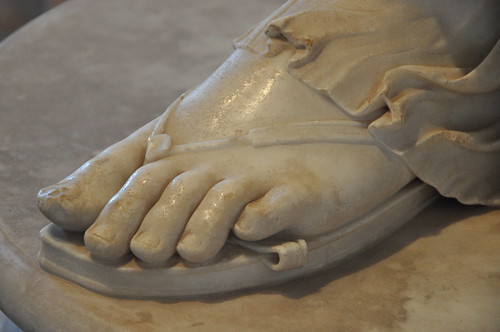

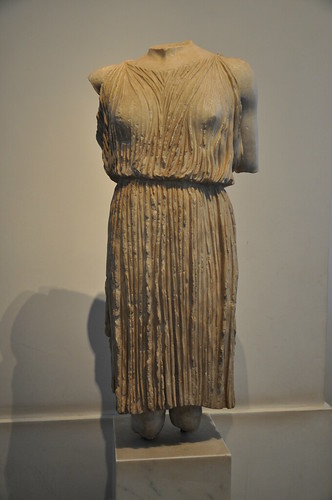

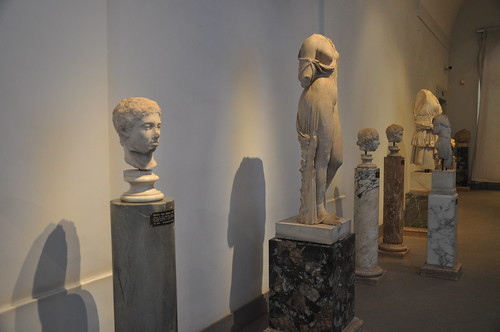


Sem comentários:
Enviar um comentário